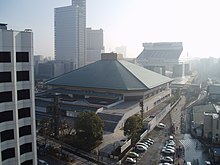Ryogoku station
| Ryogoku station | |
|---|---|
 JR platform of Ryogoku Station
|
|
| Data | |
| Design | Through station |
| Platform tracks | 3 |
| abbreviation | レ ウ ( Re-U ) / Subway: 両 ( Ryō ) |
| opening | April 5, 1904 |
| location | |
| City / municipality | Sumida |
| prefecture | Tokyo |
| Country | Japan |
| Coordinates | 35 ° 41 '46 " N , 139 ° 47' 33" E |
| Railway lines | |
| List of train stations in Japan | |
The Ryōgoku Station ( Jap. 両国駅 , Ryōgoku-eki ) is located in Sumida-ku in Tokyo . Today it is a through station on the Chūō-Sōbu line of the JR Higashi-Nihon ( JR East ) and serves local transport. From 1904 to 1932 it was the starting point of the Sōbu main line as a terminal station .
history
On April 5, 1904, the station was opened by the private railway company Sōbu Tetsudō as Ryōgokubashi ( 両 国 橋 , "Both Provinces Bridge"). As a terminus, it was the starting point of the Sōbu main line . The Ryogokubashi crosses the Sumida about a hundred meters south of the station. The name comes from the fact that the Sumida formed the border between the former provinces of Musashi and Shimousa . In 1907 the station was nationalized with the railway line and became the property of the State Railways ( kokutetsu ).
In 1931 the station was given its current name. A year later, it became a through station by extending the Sōbu main line to Ochanomizu . The new tracks were laid immediately south of the old ones, the end tracks initially remained in operation: Since initially only the new western part of the line was electrified, the station remained the starting point for many trains. Today the end tracks are closed except for one that is used for special trains and operational purposes.
In 1972 an underground connection to Tokyo station was completed, the tunnel exit of which is directly north of the old terminal station. However, no platform has been created, only through express trains run there. The Ayame and Suigō express trains ran to Ryōgoku station until 1988 , after which only the local trains of the Chūō-Sōbu line stopped. With the privatization of the state railway, the station became the property of JR Higashi-Nihon in 1987.
In 2000, the Toei Ōedo line metro station opened. It is operated by the Tokyo Prefecture Department of Transportation .
Lines
Above ground, the trains of the Chūō-Sōbu line stop at platforms 1 (towards Akihabara, Shinjuku) and 2 (towards Funabashi, Chiba) at an island platform. Track 3 on a platform of the old terminal station is connected to the Sōbu express train line and is only used operationally and for special trains. The subway station of the Ōedo line has a central platform with two tracks. It is located under the Kiyosumi-dōri at the east end of the station.
|
←
|
Lines |
→
|
||
|---|---|---|---|---|
| Asakusabashi |
|
Kinshicho | ||
| Kuramae |
Toei Subway |
Morishita | ||
Surroundings

The station is on the east bank of the Sumida at the southern end of the Yokoami district, with the Ryōgoku district immediately south of the station. Immediately north of the train station is the Ryogoku Kokugikan , where the sumo tournaments in Tokyo take place in January, May and September . Next to it is the Kyū-Yasuda-teien , a famous Japanese garden, and the Edo-Tokyo Museum .
use
In 2006, an average of 39,406 people used the JR Line and 24,020 people used the Toei Line at this station every day.
Individual evidence
- ↑ 昭和 8 年 頃 の 両 国 橋 . In: Sumida City. Archived from the original on January 15, 2010 ; Retrieved July 27, 2016 (Japanese).
- ↑ Passengers boarding in Ryogoku. Calculation from sold single, collective and monthly tickets.

